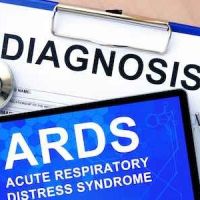A new analysis of data from patients enrolled in high-quality ARDSnet trials showed no difference between patients with moderate-severe and mild-moderate ARDS in terms of mortality, even though there were differences in rapid resolution of ARDS, ventilator-free days and ICU-free days. The research is published online in Annals of the American Thoracic Society.
According to the Berlin definition, the acute respiratory distress syndrome (ARDS) is classified as mild, moderate and severe by using an arterial partial pressure of oxygen to fraction of inspired oxygen (PaO2/FiO2) threshold of 300, 200 and 100 mmHg, respectively. However, a PaO2/FiO2 threshold of 150 mmHg has been used to define severe ARDS and to determine eligibility in therapeutic randomised controlled trials examining interventions, such as prone positioning and neuromuscular blockade.
In this analysis, researchers explored the clinical significance of the 150 mmHg threshold by examining whether patients with moderate-severe ARDS have worse clinical outcomes than patients with mild-moderate ARDS. They performed a secondary analysis of patient-level data from the three most recently published ARDS Network (ARDSNet) randomised controlled clinical trials, namely the ALTA, EDEN and SAILS. These trials compared aerosolised albuterol versus placebo, initial trophic versus full enteral feeding, and rosuvastain versus placebo. Patients having 100< PaO2/FiO2≤200 mmHg at the time of trial enrolment (i.e., patients classified as having moderate ARDS according to the Berlin definition) were separated into two subgroups, namely a moderate-severe (100
Given that PaO2/FiO2 varies throughout ARDS and depends on ventilator strategy, researchers chose for subgroup allocation the PaO2/FiO2 at trial enrolment, when all patients were ventilated according to a standardised lung protective strategy, which included a minimum positive end-expiratory pressure of 5 cmH2O. In this analysis, the primary outcome was all-cause 60-day mortality, with patients discharged from hospital with unassisted breathing before 60 days being considered to be alive at 60 days. Proportion of patients with rapidly resolving ARDS, ventilator-free days and intensive care unit (ICU)-free days were the secondary outcomes.
Of 1,634 patients included in the analysis, 870 (53.2%) had moderate ARDS, according to the Berlin definition. There was no difference between patients with moderate-severe (n=467) versus mild-moderate (n=403) ARDS in terms of baseline clinical characteristics.
Data analysis revealed all-cause 60-day mortality was not different between patients with moderate-severe and mild-moderate ARDS [104/467 (22.3%) versus 91/403 (22.6%); p=0.98]. Consistently, the probability of death over time was not different between comparators (p=0.71 by log-rank test). However, a smaller proportion of patients with moderate-severe [26/467 (5.6%)] than patients with mild-moderate ARDS [45/403 (11.2%); p=0.004] had the ARDS resolve rapidly. Also, patients with moderate-severe ARDS had fewer ventilator-free days [median 18 (IQR 0-23) vs. 21 (0-25); p=0.001] and fewer ICU-free days [16 (0-21) vs. 18 (1-22); p=0.007] than patients with mild-moderate ARDS.
"Similar to the study by Maiolo et al., we found that patients with moderate-severe ARDS had higher plateau pressure and more dead space than patients with mild-moderate ARDS. This difference in physiological parameters was accompanied by differences in clinical outcomes, such as rapid resolution of ARDS, ventilator-free days and ICU-free days," the researchers explain.
While the study by Maiolo et al. showed that “recruitability” was very different between the moderate-severe and mild-moderate subgroups, suggesting differential treatment responsiveness in mechanical ventilation interventions, the researchers note that they did not explore the predictive validity of the PaO2/FiO2 threshold of 150 mmHg (i.e., whether it predicts different responses to therapy).
"Rather, we only explored the prognostic validity of the PaO2/FiO2 threshold of 150 mmHg (i.e., whether it predicts different outcomes)," the researchers point out. "Therefore, whether there should be a distinction between moderate-severe and mild-moderate ARDS based on treatment responsiveness remains an open question."
Image Credit: Pixabay
References:
Oromendia C, Siempos II (2018) Reclassification of Acute Respiratory Distress Syndrome: A Secondary Analysis of the ARDS Network Trials. Ann Am Thorac Soc. Articles in Press. Published on 03-May-2018 as 10.1513/AnnalsATS.201803-192RL
Latest Articles
acute respiratory distress syndrome, ARDS, ICU-free days, ventilator-free days
A new analysis of data from patients enrolled in high-quality ARDSnet trials showed no difference between patients with moderate-severe and mild-moderate ARDS in terms of mortality, even though there were differences in rapid resolution of ARDS, ventilato



























